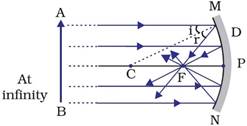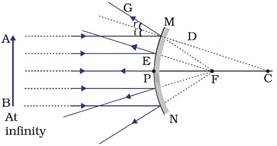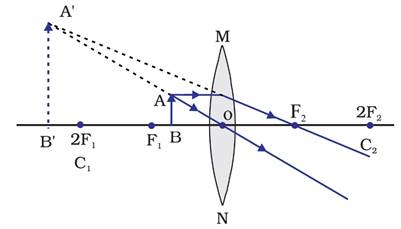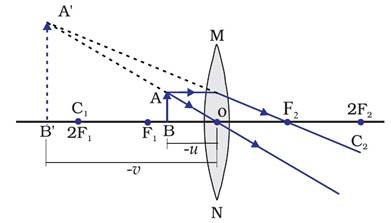i. Define the following terms in the context of spherical mirrors:
A. Pole
B. Centre of curvature
C. Principal axis
D. Principal focus
ii. Draw ray diagrams to show the principal focus of a:
A. Concave mirror
B. Convex mirror
iii. Consider the following diagram in which M is a mirror, P is an object and Q is its magnified image formed by the mirror.
State the type of the mirror M and one characteristic property of the image Q.

OR
i. Draw a ray diagram to show the formation of image by a convex lens when an object is placed in front of lens between its optical centre and principal focus.
ii. In the above ray diagram mark the object-distance (u) and the image-distance (v) with their proper signs (+ve or –ve as per the new Cartesian sign convention) and state how these distances are related to the focal length (f) of the convex lens in this case.
iii. Find the power of a convex lens which forms a real, and inverted image of magnification-1 of an object placed at a distance of 20 cm from its optical center.
i. A. Pole-The center of the reflecting surface of a spherical mirror is a point called the pole. It lies on the surface of the mirror. The pole is usually represented by the letter P.
B. Center of curvature-The reflecting surface of a spherical mirror forms a part of a sphere. This sphere has a center. This point is called the center of curvature of the spherical mirror. It is represented by the letter C.
C. Principle Axis- The imaginary line which connects the pole to the center of curvature is called the principle axis.
D. Principal Focus- A number of rays parallel to the principal axis are falling on a spherical, reflected rays are all meeting/intersecting (or intersects when extended backwards and/or forward) at a point on the principal axis of the mirror. This point is called the principal focus of the concave mirror
ii. A. Concave mirror

B. Convex Mirror

i. The mirror is concave mirror as a concave mirror makes a magnified virtual image of the object when it is placed between the focus and pole of the mirror. The image is virtual, erect and magnified.
OR Part
i. 
ii. 
The lens formula is
![]() where v is the image distance, u is the object distance, f is the focal length (both as per the sign convention). For the above situation the formula can be written as,
where v is the image distance, u is the object distance, f is the focal length (both as per the sign convention). For the above situation the formula can be written as,
![]()
iii. The data given is:
the object distance is, ![]() ,
,
the magnification is, m![]() ,
,
we know that the magnification for lens is given by the formula ,
![]() , where,
, where,
V is the image distance, u is the object distance, ho is the object size and hiis the image size.
Calculations:
So, after substituting the data we have,
![]()
So, we get ![]() .
.
So using the lens formula we can obtain the focal length of the lens
![]() , where the symbols have the usual meanings.
, where the symbols have the usual meanings.
Substituting the given and founded data, we can write,
![]()
So, f = 10 cm
We know that power of a lens is the reciprocal of the focal length in metes,
![]() .
.
P = 10 D.